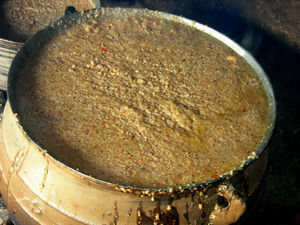Advertisement
Published: November 21st 2007

 Bon Appetite
Bon Appetite
This is lunch! Millet Porridge. The kitchen is filled with bags that read USAID. The classrooms are also filled with USAID tins. The school depends on funding from outside the country to feed the children. My collegue at Radio Justice Adams Abdul Sammed and I went to visit the Yilonaayili Anglican Primary School earlier this month.
Sammed first became interested in this school when he met one of the teachers Madame Judith. She told him about some of the challenges at the school (such as overcrowding) and how she has been trying to help some of the students who come from very poor families.
We spent the morning at the school talking to the teachers and meeting the students.
Here is a photo essay on what we found.
Yilonaayili Anglican Primary School is is the only school in the area and it supports over 20 villages. At first the school had trouble with enrollment - but that has all changed since the school introduced a school feeding program. Catholic Relief Services introduced the program in the Northern part of the country and as a result enrollment in many schools increased. The school feeding program faces an uncertain future and schools such as Yilonaayili worry about their future enrollment. The school only receives funding to feed the primary students - but the teachers did not feel right feeding the primary students without feeding their younger brothers

 Feeding Program Line Up
Feeding Program Line Up
These children are lined up for their lunch meal of millet porridge. It is provided free of charge -- and it's the reason why many of them have come to school. and sisters in the nursery school. The school is now footing the cost of expanding the feeding program to all students - now the teachers can be sure that all students are getting at least one meal a day.
*Editors Note: All interviews done with the students were conducted in Dagboni language by Adams Abdul Sammed. He has a soft spot for children without parents. Not all of the children at the school were orphans -- but a seemingly large percentage appeared to be.
Advertisement
Tot: 0.047s; Tpl: 0.014s; cc: 6; qc: 24; dbt: 0.0247s; 1; m:domysql w:travelblog (10.17.0.13); sld: 1;
; mem: 1.1mb

 Bon Appetite
Bon Appetite
 Feeding Program Line Up
Feeding Program Line Up




























